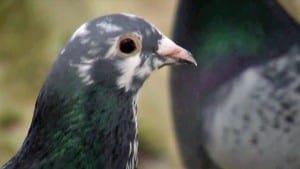 As many as 10,000 band-tailed pigeons may have died in California this winter, according to Krysta Rogers, an environmental scientist with the California Department of Fish and Wildlife (CDFW). Hard numbers are difficult to produce, because birds are difficult to monitor, but these estimates are based on reports of dead birds submitted by the public.
As many as 10,000 band-tailed pigeons may have died in California this winter, according to Krysta Rogers, an environmental scientist with the California Department of Fish and Wildlife (CDFW). Hard numbers are difficult to produce, because birds are difficult to monitor, but these estimates are based on reports of dead birds submitted by the public.
Band-tailed pigeons are California’s only native pigeon.
They are the West Coast version of the passenger pigeon, which was once the most abundant bird in North America, but it was hunted to extinction. Millions of band-tailed pigeons used to inhabit California but almost became extinct, and much of their habitat was destroyed. They were eventually protected by the Migratory Bird Treaty Act of 1918.
Band-tailed pigeons are not listed as endangered. The pigeons spend their winters in the higher elevations of California’s mountain ranges before migrating in early spring to the northernmost regions of Northern California, Oregon, Washington and British Columbia.
The sudden increase in mortality is disturbing and sad, especially because the closest living relative to the extinct passenger pigeon has been struggling for decades to recover from rampant hunting, habitat loss and other environmental problems.
Blame Non-Native Species and the Drought
The CDFW blames the deaths on Avian Trichomonosis, a disease caused by a single-celled microscopic protozoan parasite believed to have co-evolved with the common rock pigeon, which was introduced from Europe. It causes lesions to form in infected birds’ mouths and throats. The birds, which subsist largely on acorns that they swallow whole, are unable to move food down their throats and starve or can even suffocate.
What a horrible way to die.
Scientists believe that water sources, like bird feeders and stagnant pools, may play a role, and especially in the current drought conditions in California.
“These events seem to be more common in winters with less precipitation, so I do suspect there is some weather component in these mortality events,” Rogers said. “When you have large flocks and there is a disease like this circulating, and you have stagnant pools and puddles and not much flowing water, the parasite can become more concentrated in that small amount of water and the disease is going to spread more easily.”
As a result, California wildlife authorities are asking residents to take down bird baths and feeders if they spot sick or dead birds in their yards as experts closely monitor the massive die-off.
Destruction by Non-Native Species
I am reminded of what happened in New Zealand, a country I visited a month ago.
For millions of years, there were no land mammals in the country, so New Zealand birds evolved in isolation. Free from attack and competition from mammals, many birds became flightless ground-dwellers.
Migrating to New Zealand around 1250–1300, Polynesians brought kiore (the Pacific rat) and other animals. That spelled doom for those flightless birds.
The first birds to become extinct, within a century or two after human arrival, were the largest – all species of moa, both species of goose, and both adzebill species. Being flightless, all were quite easy to hunt and catch, yielding large quantities of meat. Their slow breeding rate meant they were lost faster than they could be replaced.
The list of New Zealand species known to have become extinct since human settlement includes one bat, at least 51 birds, three frogs, three lizards, one freshwater fish, four plant species, and a number of invertebrates
Then came the second wave of destruction. Europeans came in the late 18th century, bringing rats, cats, stoats, weasels and ferrets. The rabbit was introduced as a food and game animal by European settlers and by the 1870s, it was becoming a serious threat to the newly developed farming economy.
Farmers began demanding the introduction of mustelids (including stoats) to control the rabbit plague. Warnings about the dangers to bird life from stoats were given by scientists in New Zealand and Britain. However, the warnings were ignored and stoats began to be introduced from Britain in the 1880s. Within six years, drastic declines in bird populations were noticed.
The destruction in New Zealand continues.
And now the pattern is repeating itself in California, this time with the European-introduced rock pigeon potentially wiping out the native band-tailed pigeon.
How sad that tales of non-native species causing destruction keep repeating themselves around the world.
About Pigeon Patrol:
Pigeon Patrol Products & Services is the leading manufacturer and distributor of bird deterrent (control) products in Canada. Pigeon Patrol products have solved pest bird problems in industrial, commercial, and residential settings since 2000, by using safe and humane bird deterrents with only bird and animal friendly solutions. At Pigeon Patrol, we manufacture and offer a variety of bird deterrents, ranging from Ultra-flex Bird Spikes with UV protection, Bird Netting, 4-S Gel and the best Ultrasonic and audible sound devices on the market today.
Voted Best Canadian wholesaler for Bird Deterrent products four years in a row.
Contact Info: 1- 877– 4– NO-BIRD (www.pigeonpatrol.ca)

